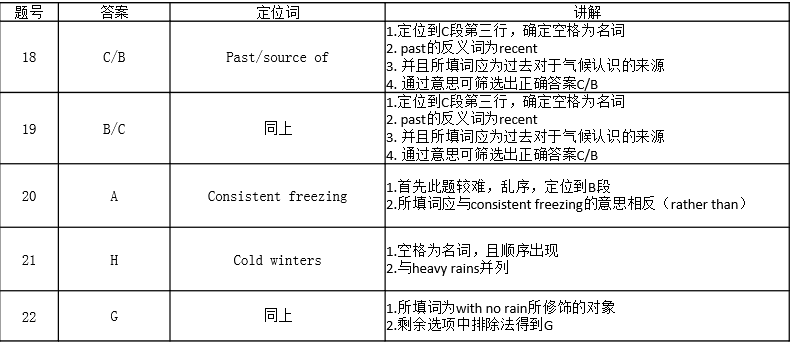托福阅读插入题到底应该插在哪里?实例分析考点思路。今天小编给大家带来托福阅读插入题到底应该插在哪里,希望可以帮助到大家,下面小编就和大家分享,来欣赏一下吧。
托福阅读插入题到底应该插在哪里?实例分析考点思路
托福阅读插入题到底考什么?
做题之前,我们先一起了解下,托福阅读题的出题意图是什么:
1、考查是否理解文章内部逻辑关系。
一般考查段落内部-句子之间的逻辑关系,有时也会考查段落之间的逻辑关系。
2、考查是否知道段落间重要的指示词和连词的作用。
只有了解起着文章衔接作用的连词的用法,才能紧随文章逻辑。
托福阅读插入题解题思路实操演练
例:
Look at the four squares ■that indicate where the following sentence could be added to the passage.
In either case, the heated water will usually be under considerable pressure, and so may have a temperature that is well above its sea-level boiling point of 100 centigrade.
Earth's internal heat, fueled by radioactivity, provides the energy for plate tectonics and continental drift, mountain building, and earthquakes. It can also be harnessed to drive electric generators and heat homes. Geothermal energy becomes available in a practical form when underground heat is transferred by water that is heated as it passes through a subsurface region of hot rocks (a heat reservoir) that may be hundreds or thousands of feet deep. ■【A】The water is usually naturally occurring groundwater that seeps down along fractures in the rock; less typically, the water is artificially introduced by being pumped down from the surface. ■【B】The water is brought to the surface, as a liquid or steam, through holes drilled for the purpose.■【C】 By far the most abundant form of geothermal energy occurs at the relatively low temperatures of 80° to 180° centigrade. ■【D】Water circulated through heat reservoirs in this temperature range is able to extract enough heat to warm residential, commercial, and industrial spaces.More than 20,000 apartments in France are now heated by warm underground water drawn from a heat reservoir in a geologic structure near Paris called the Paris Basin. Iceland sits on a volcanic structure known as the Mid-Atlantic Ridge. Reykjavik, the capital of Iceland, is entirely heated by geothermal energy derived from volcanic heat.
(官方真题Official-21: Geothermal Energy)
做句子插入题主要依赖的是语言线索,所以
第一步:仔细阅读待插入的句子,弄清含义,找出其中包含的衔接手段,预测可能存在的语境。也就是:In either case, the heated water will usually be under considerable pressure, and so may have a temperature that is well above its sea-level boiling point of 100 centigrade.
句子中出现“either case”, either表示两者中“或者,任一”,意味着原文必提及两种“case”;
第二步:读原文,找线索
■ The water is usually occurring groundwater that seeps down along fractures in the rock; less typically, the water is artificially introduced by being pumped down from the surface. ■ The water is brought to the surface, as a liquid or steam, through holes drilled for the purpose.■ By far the most abundant form of geothermal energy occurs at the relative low temperature of 80 to 180℃entigrade.■
我们发现原文首句提及“The water is usually occurring groundwater that seeps down along fractures in the rock;”一种情况外,还提到了“less typically, the water is artificially introduced by being pumped down from the surface”这种情况,满足了“两种case”的猜测。
于是,我们把待插入句放到第二个小黑框前,检查一遍,逻辑通顺。
这道题中我们的解题突破口是一个叫“either”的词,除它以外,还有哪些词可能有逻辑衔接担当呢?
常见衔接手段:
1.语法衔接手段
语法衔接手段主要指代词,包括指示代词和人称代词。
指示代词:this, these, it, such, another, that, these, those
b. 人称代词:he, she, one, they, his, her, one’s, their
c. 定冠词:the
d. such, either, same等
说明插入句的内容上文有提到。
2. 逻辑衔接手段:
a. 因果: because, therefore, thus, consequently, so, as a result
b. 对比: however, on the contrary, nevertheless, unlike, in contrast, while, although, but
c. 递进: furthermore, also, as well, too, other, in addition, moreover, besides, even, additionally
托福阅读真题原题+题目
Because the low latitudes of the Earth, the areas near the equator, receive more heat than the latitudes near the poles, and because the nature of heat is to expand and move, heat is transported from the tropics to the middle and high latitudes. Some of this heat is moved by winds and some by ocean currents, and some gets stored in the atmosphere in the form of latent heat. The term latent heat refers to the energy that has to be used to convert liquid water to water vapor. We know that if we warm a pan of water on a stove, it will evaporate, or turn into vapor, faster than if it is allowed to sit at room temperature. We also know that if we hang wet clothes outside in the summertime they will dry faster than in winter, when temperatures are colder. The energy used in both cases to change liquid water to water vapor is supplied by heat — supplied by the stove in the first case and by the Sun in the latter case. This energy is not lost. It is stored in water vapor in the atmosphere as latent heat. Eventually, the water stored as vapor in the atmosphere will condense to liquid again, and the energy will be released to the atmosphere.
In the atmosphere, a large portion of the Sun's incoming energy is used to evaporate water, primarily in the tropical oceans. Scientists have tried to quantify this proportion of the Sun's energy. By analyzing temperature, water vapor, and wind data around the globe, they have estimated the quantity to be about 90 watts per square meter, or nearly 30 percent of the Sun's energy. Once this latent heat is stored within the atmosphere, it can be transported, primarily to higher latitudes, by prevailing, large-scale winds. Or it can be transported vertically to higher levels in the atmosphere, where it forms clouds and subsequent storms, which then release the energy back to the atmosphere.
1. The passage mainly discusses how heat
(A) is transformed and transported in the Earth's atmosphere
(B) is transported by ocean currents
(C) can be measured and analyzed by scientists
(D) moves about the Earth's equator
2. The passage mentions that the tropics differ from the Earth's polar regions in which of the
following ways?
(A) The height of cloud formation in the atmosphere.
(B) The amount of heat they receive from the Sun.
(C) The strength of their large scale winds.
(D) The strength of their oceanic currents.
3. The word convert in line 6 is closest in meaning to
(A) mix
(B) change
(C) adapt
(D) reduce
4. Why does the author mention the stove in line 10?
(A) To describe the heat of the Sun.
(B) To illustrate how water vapor is stored.
(C) To show how energy is stored.
(D) To give an example of a heat source.
5. According to the passage , most ocean water evaporation occurs especially
(A) around the higher latitudes
(B) in the tropics
(C) because of large-scale winds
(D) because of strong ocean currents
6. According to the passage , 30 percent of the Sun's incoming energy
(A) is stored in clouds in the lower latitudes
(B) is transported by ocean currents
(C) never leaves the upper atmosphere
(D) gets stored as latent heat
7. The word it in line 18 refers to
(A) square meter
(B) the Sun's energy
(C) latent heat
(D) the atmosphere
8. The word primarily in the line 19 is closest in meaning to
(A) chiefly
(B) originally
(C) basically
(D) clearly
9. The word prevailing in line 19 is closest in meaning to
(A) essential
(B) dominant
(C) circular
(D) closest
10. All of the following words are defined in the passage EXCEPT
(A) low latitudes(line 1)
(B) latent heat (line 5)
(C) evaporate (line 7)
(D) atmosphere (line 14)
PASSAGE 87 ABBDB DCABD
托福阅读真题原题+题目
Generally, in order to be preserved in the fossil record, organisms must possess hard body parts such as shells or bones. Soft, fleshy structures are quickly destroyed by predators or decayed by bacteria. Even hard parts left on the surface for a certain length of time will be destroyed. Therefore, organisms must be buried rapidly to escape destruction by the elements and to be protected against agents of weathering and erosion. Marine organisms thus are better candidates for fossilization than those living on the land because the ocean is typically the site of sedimentation, whereas the land is largely the site of erosion.
The beds of ancient lakes were also excellent sites for rapid burial of skeletal remains of freshwater organisms and skeletons of other animals, including those of early humans. Ancient swamps were particularly plentiful with prolific growths of vegetation, which fossilized in abundance. Many animals became trapped in bogs overgrown by vegetation. The environment of the swamps kept bacterial decay to a minimum, which greatly aided in the preservation of plants and animals. The rapidly accumulating sediments in flood plains, deltas, and stream channels buried freshwater organisms, along with other plants and animals that happened to fall into the water.
Only a small fraction of all the organisms that have ever lived are preserved as fossils. Normally, the remains of a plant or animal are completely destroyed through predation and decay. Although it seems that fossilization is common for some organisms, for others it is almost impossible. For the most part, the remains of organisms are recycled in the earth, which is fortunate because otherwise soil and water would soon become depleted of essential nutrients. Also, most of the fossils exposed on Earth's surface are destroyed by weathering processes. This makes for an incomplete fossil record with poor or no representation of certain species.
The best fossils are those composed of unaltered remains. Generally, it is the inorganic hard parts, composed mostly of calcium carbonate, that form the vast majority of unaltered fossils. Calcite and aragonite also contributed to a substantial number of fossils of certain organisms.
1. According to the passage , an organism without hard body parts
(A) is not likely to appear in the fossil record
(B) is not heavy enough to sink below the surface
(C) is not attractive to predators
(D) takes a long time to decay
2. The word agents in line 5 is closest in meaning to
(A) dangers
(B) examples
(C) areas
(D) causes
3. Why are marine organisms good candidates for fossilization?
(A) They have more fleshy structures than land organisms.
(B) It is likely that they will be buried rapidly.
(C) The water environment speeds the decay caused by bacteria.
(D) It takes longer for them to be preserved.
4. The fact that the land is largely the site of erosion (line 7 - 8) is significant because
(A) erosion is less destructive than sedimentation.
(B) fossils are most common in areas subject to erosion.
(C) erosion contributes to the destruction of skeletal remains.
(D) few organisms live in areas that experience extensive erosion.
5. According to the passage , why were the remains of organisms trapped in swamps better
preserved for the fossil record than those that were not?
(A) The swamp environment reduced the amount of bacterial decay.
(B) Swamp waters contained higher amounts of materials such as calcium carbonate.
(C) There were fewer sediments in swamps than in other bodies of water.
(D) Swamp vegetation accelerated the decomposition of organisms.
6. The word aided in line 13 is closest in meaning to
(A) reversed
(B) helped
(C) reformed
(D) counted
7. It can be inferred that flood plains, deltas, and stream channels (lines 14 - 15) are similar in
which of the following ways?
(A) Animals rather than plants have been preserved at such locations.
(B) Such locations are likely to be rich sources of fossils.
(C) Fossilized human remains are only rarely found in such locations.
(D) Rapid sedimentation in such locations makes it difficult to locate fossils.
8. What is the author's main point in paragraph 3?
(A) Weathering makes it impossible to identify many fossils.
(B) Many fossils have been buried forever under the soil.
(C) Fossils provide a limited sample of ancient organisms.
(D) It is easier to find the remains of plants than animals.
9. Why does the author mention aragonite in line 27
(A) To explain why fossils are rare
(B) To compare aragonite fossils and calcite fossils
(C) To argue that certain fossils are more informative than others
(D) To illustrate the kinds of inorganic hard parts that can form fossils
PASSAGE 88 ADBCA BBCD
托福阅读插入题到底应该插在哪里相关文章:
★ 托福阅读长难句分析汇总






